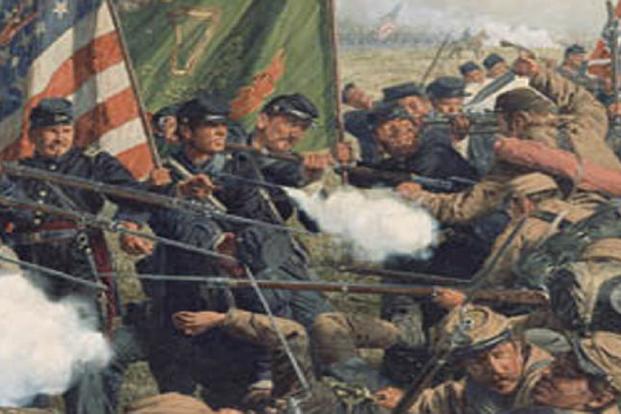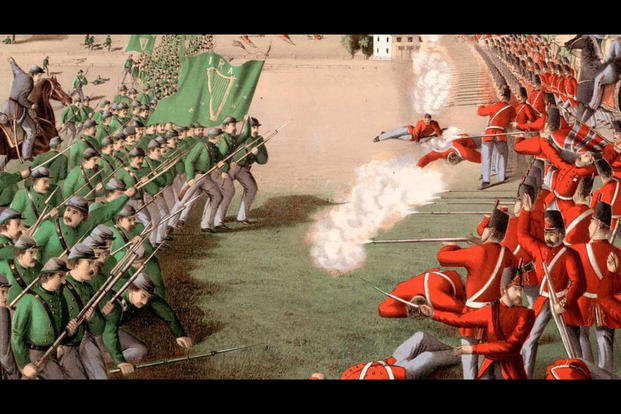In the years following the American Civil War, Canada was still very much a possession of the British Empire. As such, it had a number of official fortifications and other important areas along its border with the United States.
One of those was Fort Erie, directly across the Niagara from the American city of Buffalo, New York. In June 1866, some 850 men crossed the Niagara from Buffalo, intent on capturing the fort.
They were Irishmen, and they were going to conquer Canada to free their home country.

Irish immigrants flowed into the United States in droves following the Acts of Union that saw British domination of Ireland since the early 1800s. The Great Irish Famine of the late 1840s also saw a huge emigration of Irish people to the United States.
By 1860, there were more than 1.6 million people of Irish descent who called themselves American – and upwards of 175,000 of them were about to serve in the Union Army.
The Irish made-up 40 percent of foreign-born enlistments in the Civil War, and were 17 percent of the overall Union force. When these battle-hardened veterans returned home after the war, many of them were headed to New York, Pennsylvania, New Jersey, and New England. It was there that Irish National leaders were waiting to use the veterans' new talent for combat.

Called the Fenian Brotherhood, its original aim was to send money, arms, and supplies to Irish rebels in Ireland via Irish émigrés living in the U.S. Many in the movement were soon convinced that liberating Ireland through a direct uprising was impossible, so they decided to step up their game a bit.
If the Irish couldn't mount an invasion of Ireland, then they would mount an invasion of Canada, the nearest British-held country and trade it for Irish independence.
T.W. Sweeny a former Union general who also served in the Mexican War hatched a three-pronged plan to invade Canada, set up an Irish government-in-exile, and pressure Britain to release Ireland to the Irish. It called for multiple incursions into Ontario in an effort to draw the main British force out of Quebec. With that done, the main Fenian force would invade Quebec, cutting off lines of communication and supply.

On June 1, 1866, a force of Irish-American members of the Fenian Brotherhood landed in Ontario and planted the Irish flag. They tore up railroads and cut the telegraph wires, effectively cutting Fort Erie off from the rest of Canada.
Then, 600 Fenians marched westward. At the same time, the commander of British forces in Canada activated upwards of 22,000 troops to put the insurrection down. While the larger force formed up, 850 men under Lt. Col. Alfred Booker were dispatched to pin the Irish down and keep them from wreaking any more havoc.
The two forces met at Ridgeway in Ontario, Canada. It was the first time an all-Canadian force was led by a Canadian commander. Unfortunately for the Canadians, the Fenians were well-armed and skilled fighters, having just braved the battlefields of the American Civil War. The Canadians were soon reinforced, and the superior numbers caused the Fenians to retreat.

The Fenians were repulsed elsewhere along their proposed lines of attack. Having assumed that Irish Canadians would join the uprising, they were surprised at how the Canadians responded to their invasion.
By the time British forces mounted a full response, many of the Fenians had retreated back across the river, the United States Navy was stopping Fenian barges from bringing reinforcements, and the U.S. declared total neutrality in Canadian affairs.
There would be more Fenian uprisings in later years, but for the time being, the push to trade Canada for Ireland would not come to pass.
MORE POSTS FROM WE ARE THE MIGHTY:
Gina Elise knows how to make a first impression
The true, bloody story of Delta Force's ironman
The 'Yucca Man' is a beast that stalks Marines at 29 Palms
We Are The Mighty (WATM) celebrates service with stories that inspire. WATM is made in Hollywood by veterans. It's military life presented like never before. Check it out at We Are the Mighty.




